The 12 Biggest Facebook Ads Mistakes We Find in Accounts

With over 9 million active advertisers, Facebook is far from just a social media platform. It has become an integral part of a customer’s journey, and has been found to heavily influence consideration and even drive direct sales depending on your industry.
While Facebook may have seen a few struggles in recent months (see here and here), it still provides a great opportunity for advertisers of all sizes to show up in front of their target audience.
Are you thinking of taking the dive into Facebook advertising? As creators of hundreds of Facebook Ads campaigns, we want to share a few of the most common mistakes we see when we take over accounts from clients, and what you can do to start your advertising campaigns on their best foot.
Facebook Ads 101
We hope you know most of this already, but just in case, here’s a quick refresher about using Facebook Ads Manager.
- Running ads through Facebook Ads Manager allows you to show ads on Facebook, Instagram, Messenger, and various websites through Facebook’s Audience Network. You can choose to run on certain platforms over others, or you can let Facebook drive with “Automatic Placements”.
- Facebook ads are very visual in nature. They consist of photos, video, GIFs, and carousels.
- Ads that run through Facebook are designed to look native to the platform. If these ads are running in the feed on Facebook or Instagram, they will look like a post, and can be interacted with like any post on that platform.
- Facebook Advertising is a form of push marketing. Advertisers choose their target audience and serve ads accordingly. Since potential customers can fall into multiple audiences that are being targeted by any number of advertisers, the competition can be stiff.
- The key to a successful Facebook ad is to “stop the scroll”. Your ad needs to be enticing and engaging in order to “disrupt” a potential customer’s scroll. When scrolling through a feed, advertisers have seconds to catch the attention of their target audience or get passed over for the next dog picture.
Common Mistakes We Find In Facebook Ads
Honestly, there are probably thousands of mistakes you could possibly make in an ad account that would waste your money. From accidental budget changes to sending traffic to the wrong website, the possibilities are truly endless. However, we’ve found that the most common mistakes are small, and most advertisers don’t know they’ve made a mistake at all.
More often than not, a new JEMSU client will come to us and say “Well, we tried Facebook ads before, but it just didn’t work for us.” or even the more common “We just had no idea what we were doing in there.” Platforms like Facebook and even Google are built to have a lot of options for advertisers, which leaves a lot of opportunity for wasted spend. We’re going to break down some of the most common mistakes that we’ve seen when we jump into a new account, and help you avoid potential pitfalls in your ad campaigns.
In general, we see mistakes fall into four main categories:
- Tracking
- Campaign Setup
- Audience Targeting
- Ads
Tracking Mistakes
Not using the Facebook Pixel
Hands down, the biggest mistake we see advertisers make is not using the Facebook pixel in their advertising campaigns. Whether you sell a product online, have a storefront, are looking to drive B2B leads, or anything else in between, the Facebook pixel is going to be your best friend.
Facebook’s proprietary pixel has a number of features that can help your campaigns improve.
- Use the pixel to track conversions, like form submissions or online purchases.
- Use the pixel to create audiences based on site traffic, like people who add to cart but do not checkout.
- Use the pixel to create value-based lookalike audiences, which will find more potential customers for your ad campaigns.
Our favorite audiences at JEMSU are all informed by the Facebook pixel. Website visitor audiences can help you convert previous visitors at a lower cost. Lookalike audiences can help you find new traffic based on those who have already converted or been to your site. We often use these in our campaigns 10x our results and bring ROI to our clients.
Installing the Facebook pixel is a simple process. If you have a compatible CRM, like Shopify, you can simply paste your Facebook pixel code into the appropriate area and Facebook will do the rest. If you are using a WordPress or any other CMS, the Facebook pixel can be installed in the <head> section of your website and will start tracking within minutes.
Conversion tracking can also be very simple with the Facebook pixel. For platforms like Shopify, Facebook will automatically set up standard event tracking, including pulling your revenue numbers into your Purchase pixel. Below is a client who used the Shopify pixel setup. As you can see, multiple events were tracked automatically.
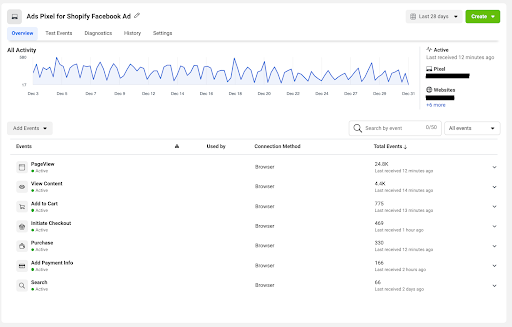
If your website isn’t compatible with the pixel, Facebook’s Event Setup tool can guide you through tracking various buttons on your website as conversions. We highly recommend that you set up as much conversion tracking as possible, as this will help you understand the return on your advertising investment.
Not using Google Analytics
We love Facebook and the Facebook pixel, but we are also huge Google fans at JEMSU. As the statistical heart to every campaign, we set up Google Analytics to make sure we get a full view of what happens on and off your website.
Google Analytics is a piece of software that tracks what users do once they get to your website. Using Google Analytics can help you find valuable insight about your website, like how long people spend on the site, which pages of your website might be causing a drop off, and who your most valuable users are.
Conversion tracking should also be set up in Google Analytics to get a holistic view of your campaign performance. Facebook uses a unique attribution model, based on both clicks of your ads and views of your ads. Because of this, Facebook can sometimes claim credit for a sale or form submission that Google would put in another bucket. It’s good to check in both platforms to get a better picture of what campaigns are working best for your business.
Campaign Setup
Not using the right campaign objective
Facebook offers 11 different campaign objectives, all depending on what type of results you’d like to see from your campaign. They are broken down into three basic categories: awareness, consideration, and conversion.

Here are all of your Facebook campaign objective options.
Awareness
- Brand Awareness
- Reach
Consideration
- Traffic
- Engagement
- App Installs
- Video Views
- Lead Generation
- Messages
Conversion
- Conversions
- Catalog Sales
- Store Traffic
The main differences between these three categories of campaigns are based on what you’d like to get from the campaigns. For example, if you just want more eyeballs on your brand, you might consider a campaign objective that falls under awareness. If you are trying to drive traffic to an information page in the hopes that you can get someone in your funnel, a traffic campaign might be best, which falls under consideration. There is no wrong campaign type, as long as you know what KPI’s are important to your business.
Not using a Conversion campaign objective when it applies
At JEMSU, our main focus is driving measurable results for our clients. This means that at the end of the day, we want our campaigns to give you leads and sales. More often than not, this leads us to choose the Conversion campaign objective when we build a campaign.
A key factor to a successful conversion campaign is to accurately track your conversions (see first mistake above). Once you can confirm that your conversion tracking is set up correctly, you can choose which conversion you’d like Facebook to optimize towards. The key to success here is to pick a conversion that you have enough data on, because Facebook requires 50 conversions over a 7 day period to adequately optimize your results. For some businesses and budgets, that’s just not going to be reasonable, but picking lower funnel conversions like email sign ups or add to carts may help you reach those numbers faster.
We see many clients come to us running traffic campaigns or post engagement campaigns and wonder why they aren’t seeing a return on their ad spend. When you choose a campaign objective, Facebook will work towards that goal. If you tell Facebook that you care more about driving traffic to your site, they will not work to drive any conversions. By choosing a conversion objective, you are in essence telling Facebook that sales and leads are most important to you.
Audience Targeting
Not leveraging demographic targeting
When you create a campaign, the default settings are to target everyone in the United states, males and females, ages 18-65+. We can comfortably state that about 80% of campaigns come to us with this setup.
Rarely is your target audience going to fall into the default Facebook settings. We recommend looking at your current customer base and mining some trends from there. Are most of your customers women ages 25-54? You might want to narrow down your targeting.
Another option, if you have some good data in your account already, is to look at some breakdowns of which audiences might be performing best. Through the breakdown menu, it’s easy to see which genders, age groups, platforms, locations, etc. are driving the most results for your campaign. Once you notice a trend, use it to your advantage!
Using audiences that are too specific
When Facebook advertising first rose to popularity, one of the biggest advantages was the ability to target specific audiences based on people’s interests, purchase behaviors, and other pieces of information. In fact, this is what ended up getting Facebook into so much trouble in recent years. Since the Cambridge Analytica scandal, Facebook has removed many options that were previously available for targeting, but still provides a robust list of interests, demographics, and behaviors that advertisers can use to target potential customers.
Sometimes, a client will come to us and say “why aren’t my ads working?” When we dig into the account, we can see that they used every possible targeting option to a detriment. Facebook allows you to narrow your audience to your desired level. However, if you end up narrowing your audience so that it only includes a handful of people, you’ll never be able to spend efficiently or potentially even get a sale.
We recommend going broader on your target audience (within reason), and then letting Facebook’s machine learning take care of the rest. If you are using campaigns that optimize around conversions, Facebook will find the right users for you without you having to have a specific audience. They work towards finding people who will complete a conversion, which can often be outside of your normal customer. This helps you have a better balanced campaign.
Not using audience exclusions
While using Facebook’s machine learning can help a campaign, you shouldn’t rely on it entirely. There are some relevant audience exclusions that can and should be made to ensure you are spending efficiently.
For example, I bought my husband a gift subscription to Atlas Coffee Club. I made the purchase on the same day that I discovered the company, as I thought it would be a great fit for Christmas. Having happily purchased the gift, I went over to Facebook to do some scrolling. The first ad that I was shown is below.
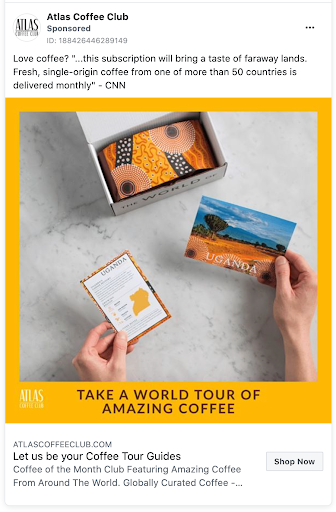
Having just bought from them, I thought “No thanks, I just purchased from you.” If this had happened just one time, that would have been fine. However, I was followed by these ads just about every other day for a month. It started to get quite annoying, and turned me off from becoming a regular customer of theirs.
In this situation, JEMSU would have created a list of those who had recently purchased a product, probably in a 30-60 day window. We’d then exclude those people from advertising, as to avoid the situation I went through. After the 30-60 day window expires, the audience would qualify to get ads again if they fall into an audience we were targeting. This little gap in targeting gives the customer time to try the product, figure out if they like it, and then potentially purchase again. This strategy tends to lead to more returning customers, which come at a lower cost than a new one.
Not using Lookalike audiences
Lookalike audiences are our absolute favorite audiences to use. They are generated by using a source audience, like people who have engaged with your Instagram or people who have been to your website in the last 30 days. Facebook allows you to make these audiences by country, will help you find similar people who might be interested in purchasing your product.
These audiences are incredibly easy to create and use in your campaign. We recommend testing multiple at a time, and always having a few on the back burner that you can test when you see an opportunity. More often than not, these Lookalike Audiences end up driving at least 50% of results in our Facebook campaigns.
Below is a typical JEMSU account setup. We create as many audiences as possible, using some and saving others for future tests. This area of Facebook ads can be found under “Audiences” and makes it easy to see all of the audiences that you have available.

Not using remarketing audiences
Remember my anecdote above about getting followed by ads from a company I had already purchased from? Sometimes this strategy can be used for good.
Remarketing audiences are generally lists of people who have been to your website but not purchased or filled out a form yet. You can target these people specifically, and offer them a special discount in order to entice a purchase. In general, people in remarketing audiences are more likely to purchase since they already know who you are.
We recommend isolating your remarketing traffic into its own campaign so you can control the spend. Sometimes this audience can be outspent by others, but is often a high performer when it is in its own campaign.
Ads
Using too many ads at once
Have you heard the phrase “Less is more”? That is often the case when it comes to advertising. While you are able to make hundreds of ads per audience, we really recommend against doing that. It is tempting to test every possible combination of headline, description, image, video, CTA button, landing page, etc., but rarely will this work out in the long run for the average advertiser.
Often, we’ll see accounts where advertisers tried running 30 different ads on a $10/day budget. While this might sound like a great way to test the waters and see what works, we often find that this ends up hurting performance. No ad is able to get enough money to get a good test sample, so all ads end up underperforming.
If you aren’t sure where to start, the JEMSU rule of thumb is to run 3-5 ads in each audience to start, testing a few different formats like video, carousel, and static ads. We also recommend split testing instead of A/B testing to start. Split testing is where you try a completely different message, image, etc. in each ad. A/B testing is where you change only one part in each variation of the ad. When you split test, you can get a better sense of what works and what doesn’t. From there, you can A/B test different elements to improve your performance.
Running ads for too long
Another problem we see often is running the same ad for too long. “Creative fatigue” is when a person gets used to an ad that they see often, so they no longer really see the ad. To avoid creative fatigue, you’ll want to switch up your ads fairly often. Facebook recommends every 1-2 weeks, but we at JEMSU think you should test one new ad every month, and switch out ads fully every 3-4 months in order to keep things fresh.
You might be thinking, “my ads are working, why wouldn’t I keep them on.” It’s true, we often see one ad be a top performer for multiple months in a row. However, audiences are only so big and just because an ad is working doesn’t mean it’s immune to creative fatigue. In cases like this, try to figure out what about that ad is working. Is it the video or picture you’ve used? Is it the messaging in the description? Maybe it’s just the landing page that you’re sending people to. The main goal is to continue to build on your success, so use this as an opportunity to test and grow.
We’ve also seen that sometimes an ad is so good that it stunts the performance of other creatives that would work just as well. Swapping the well performing ad for another often leads to other ads picking up the slack and seeing an increase in performance.
Not moderating ad comments
This is a big one, and is a problem that can often go undetected for months. In our Facebook 101 lesson, we mentioned that ads look native to the platform. That means that they act as regular Facebook posts. People can like, comment, share, etc. Unfortunately, that also means that anyone who sees the ad can post just about anything they want on your ads.
One of our clients, WiseGuise, sells face masks that have a very innovative design. Unfortunately, while they have a great product, face masks themselves are a very polarizing topic in the United States. Below is an ad of thiers, which you can see has numerous likes, comments, and shares.
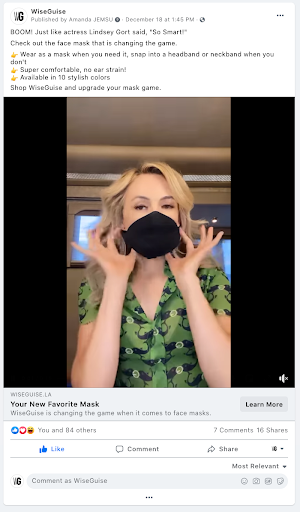
However, when you open up the comments, there are actually quite a few negative, confusing, and off the wall comments.
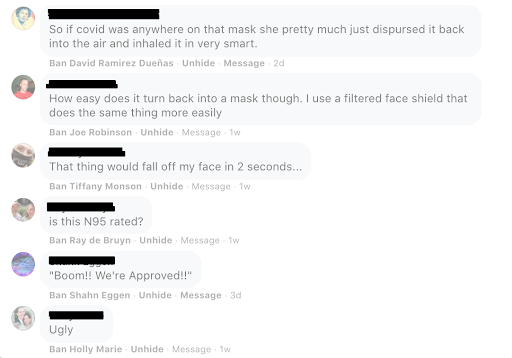
As you can see, we’ve chosen to hide these messages from the ads. Where a normal Facebook post may have restrictions on what you can hide, delete, or show, the ads have much more control. We recommend hiding comments when they are negative or outright mean.
Another common happening is people asking for more information or requesting appointments in the comments section. By not moderating your ad comments, you could be missing out on contact with potential customers who wouldn’t get all the way to your landing page to contact you. Our client, Ruff N Tuff Turf, sells and installs artificial turf lawns in the Southern California area. Looking at their comments below, you can see how many people ask for quotes, express interest, and have genuine questions about the product. This client makes it a point to check those comments and stay on top of these questions so they can continue to get more new business.
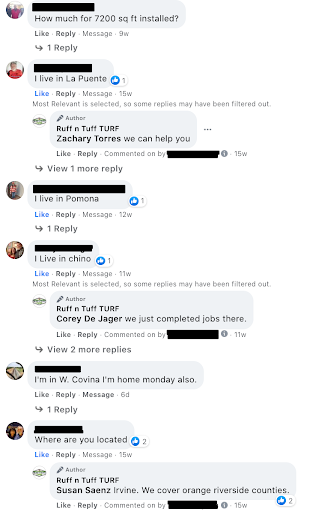
Ad comments show up in your notification center just like regular comments on posts, so it’s very easy to manage these along with your normal posts. Checking even once a day is enough to make sure that no customer question is left unanswered.
TL;DR
There are a lot of factors that could be impacting your Facebook Ad campaign performance. With this guide to common mistakes, you can avoid wasteful spend and get your campaign started on the right foot.
Still feeling overwhelmed at the challenge? JEMSU can help! We manage Facebook advertising campaigns every day, and we offer a free audit of your account to go over where you can improve. Reach out to our team today!
Your intelligent blog entry is an excellent example of your intelligence. Your careful research and analytical thinking have resulted in a contribution that is actually helpful. mapquest driving directions
Your concepts are exciting to me since they are new. Your way of thinking is reasonable, sane, and provides a comprehensive answer to the issue at hand.
when i at the start left a remark i appear to have clicked on the -notify me even as new comments are added- checkbox and any further on every occasion a remark is delivered i obtain 4 emails with the same remark. Possibly there can be a smooth technique you’re capable of putting off me that provider. Many thank you! Greetings! The very beneficial recommendation in this precise write my assignment for me article! It is the little modifications to make the maximum vital adjustments. Many thank you for sharing! You’re so exciting
when i at the start left a remark i appear to have clicked on the -notify me even as new comments are added- checkbox and any further on every occasion a remark is delivered i obtain 4 emails with the same remark. Possibly there can be an smooth technique you’re capable of put off me from that provider? Many thank you! Greetings! Very beneficial recommendation in this write my assignment for me precise article! It is the little modifications so as to make the maximum vital adjustments. Many thank you for sharing! You’re so exciting
You have given a very good point about Facebook Ads in your blog. I do digital marketing and I got a lot of information from your blog. Now I will suggest you to use this Pee Wee Herman Grey Suit in this winter season of fashion.
Do you know of any good services for renting vans in the USA? I recently discovered a website called rental24h.com which contains all the leading rental companies. There are many great offers from companies on the site, so you can compare prices and choose the best option for yourself